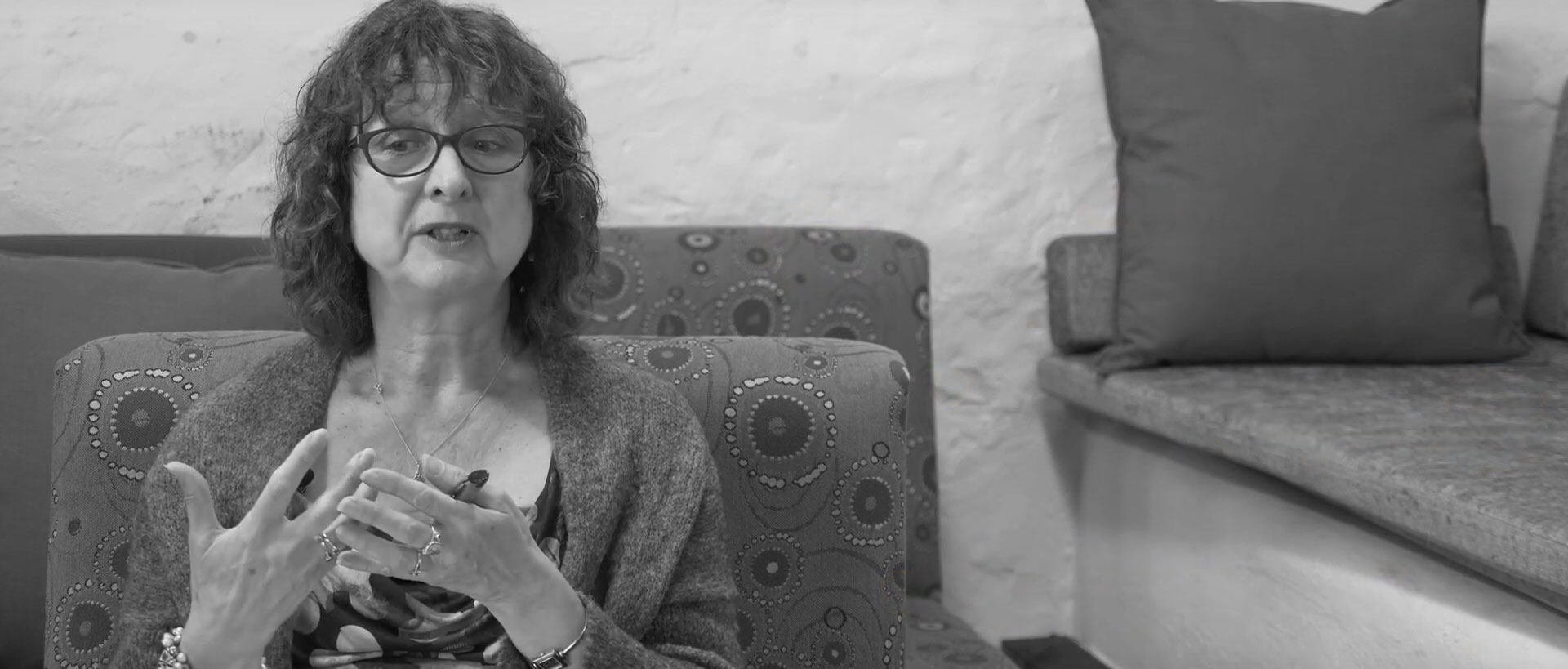 Understanding systemic change, complexity and developmentIn this video, Dr Jean Boulton (Department of Social and Policy Sciences at the University of Bath), lead author of Embracing Complexity, is in conversation with Prof Belinda Reyers (GRAID, Stockholm Resilience Centre and Future Africa, Univ Pretoria). They explore how complexity thinking can inform our understanding of how change comes about, and, based on […]
Understanding systemic change, complexity and developmentIn this video, Dr Jean Boulton (Department of Social and Policy Sciences at the University of Bath), lead author of Embracing Complexity, is in conversation with Prof Belinda Reyers (GRAID, Stockholm Resilience Centre and Future Africa, Univ Pretoria). They explore how complexity thinking can inform our understanding of how change comes about, and, based on […]In this video, Dr Jean Boulton (Department of Social and Policy Sciences at the University of Bath), lead author of Embracing Complexity, is in conversation with Prof Belinda Reyers (GRAID, Stockholm Resilience Centre and Future Africa, Univ Pretoria). They explore how complexity thinking can inform our understanding of how change comes about, and, based on their practical experience, the implications for International Development. Complexity-informed frameworks can provide perspectives that are better aligned to the challenges faced in a world that is increasingly complex, volatile and hard to anticipate.
2018-08-31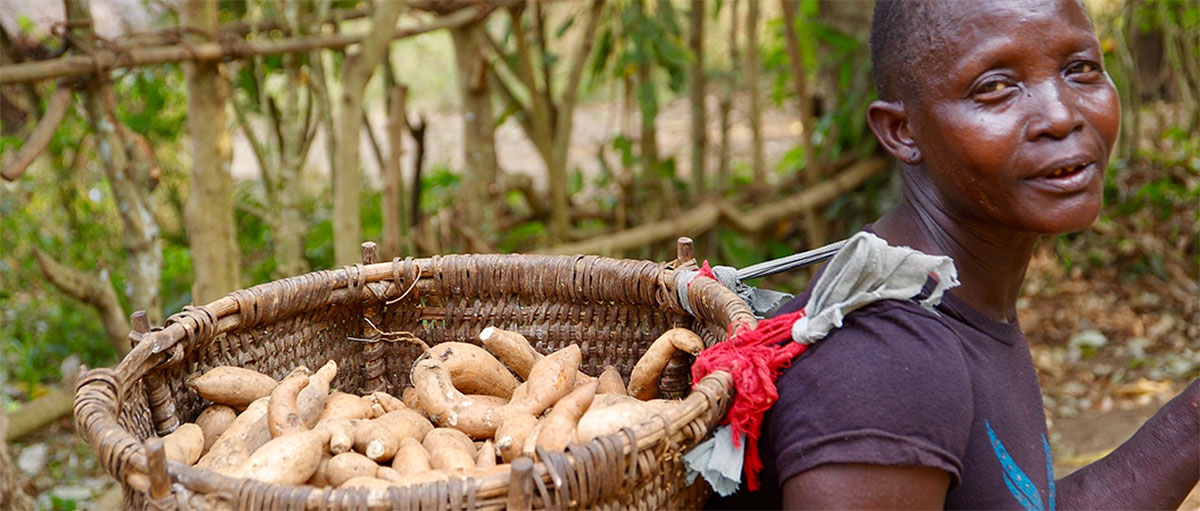 A resilient food future for the people of the forestEthiopia’s population is quickly growing, a trend in many African nations. The Ethiopian national government’s agricultural policy is increasingly following a high chemical input model in order to increase crop yields. While agriculture harvests must keep up with the demands of a growing population, it is important to understand the lasting impacts that these chemicals […]
A resilient food future for the people of the forestEthiopia’s population is quickly growing, a trend in many African nations. The Ethiopian national government’s agricultural policy is increasingly following a high chemical input model in order to increase crop yields. While agriculture harvests must keep up with the demands of a growing population, it is important to understand the lasting impacts that these chemicals […]Ethiopia’s population is quickly growing, a trend in many African nations. The Ethiopian national government’s agricultural policy is increasingly following a high chemical input model in order to increase crop yields. While agriculture harvests must keep up with the demands of a growing population, it is important to understand the lasting impacts that these chemicals have on the natural environment.
A new documentary film produced by GRAID, sheds light on the complex, interconnected and wide-ranging social-ecological factors that need to be considered and addressed when designing a sustainable and resilient food production system.
The film, entitled “Mapping Majang – cultivating a resilient food future for the people of the forest”, follows GRAID researcher Million Belay who asks the question: How can resilience-based research help to inform the development of food production systems that will deliver enough for everyone to eat, without degrading the environment and eroding culture?
The film’s narrative focuses on resilience research in one Ethiopian community experiencing multiple changes. This community lives in a forested region, and face challenges of population growth and immigration that bring about social and cultural changes. In turn, there are impacts on the environment, as a result of different farming practices and the way the forest is managed.
Using a deeply embodied understanding about his country’s political and cultural history, Belay, an Ethiopian native, uses methods based on a resilience approach to help the community find their own practical solutions to the complex problems they face.
The way in which the research is carried out, and the local level outcomes, draw on resilience-oriented research and highlight knowledge and insights relevant far beyond this forest. Furthermore, the project goes some way in translating knowledge into hands-on practical actions that can inform a more sustainable and just development approach.
Watch the film here:
2018-04-30 Stockholm Resilience Centre new host of Global Resilience Partnership secretariatThe Global Resilience Partnership (GRP), an independent partnership of public and private organizations working towards a sustainable and prosperous future for all, has moved its secretariat to the Stockholm Resilience Centre, home of GRAID. The secretariat acts as a support to the entire partnership, including several big actors in the international development sector. GRAID is […]
Stockholm Resilience Centre new host of Global Resilience Partnership secretariatThe Global Resilience Partnership (GRP), an independent partnership of public and private organizations working towards a sustainable and prosperous future for all, has moved its secretariat to the Stockholm Resilience Centre, home of GRAID. The secretariat acts as a support to the entire partnership, including several big actors in the international development sector. GRAID is […]The Global Resilience Partnership (GRP), an independent partnership of public and private organizations working towards a sustainable and prosperous future for all, has moved its secretariat to the Stockholm Resilience Centre, home of GRAID. The secretariat acts as a support to the entire partnership, including several big actors in the international development sector. GRAID is one of GRP’s knowledge partners, sharing its findings and applications with the GRP while the GRP acts a platform for GRAID’s work.
With the relocation to Stockholm Resilience Centre, GRP’s start to focus more on resilience thinking and its applications, and will also view the world as more interconnected. “We are excited to be the new host of the GRP Secretariat and see this as a real opportunity to help develop a global partnership for transformations to resilience building for sustainable development in the Anthropocene, by strengthen the synergy between knowledge and solutions,” says Johan Rockström, executive director of the Stockholm Resilience Centre.
Read more about the Global Resilience Partnership at the Stockholm Resilience Centre
The GRP will also welcome a new CEO, Deon Nel. Currently the global conservation director at the World Wildlife Fund (WWF), Nel will take on full responsibility come August. Nel hails from South Africa and has spent most of his career working in and with developing countries, particularly in Africa. In his current role at the WWF, he oversees WWF’s conservation efforts spanning around 100 countries. He also has experience with developing partnerships between the public sector, private sector, and with multilateral development banks. Furthermore, he has overseen WWF’s Global Policy & Advocacy team during the finalisation and adoption of the 2030 Sustainable Development Agenda.
Dr. Nel also believes in the importance of resilience in development. He says that:
“the world needs the thinking around resilience more than it ever needed it before. We are at a tipping point seeing risk levels higher than ever before, but the opportunity to embrace resilience is at the highest point as well. The GRP stands at a key point that we can capitalize on. This is an important and opportune moment for GRP, which I am excited to be part of and lead in the future.”
Read more about Deon Nel as the new CEO of GRP
2018-04-17 Exploring resilience through the stories of food innovators in the Western Cape, South AfricaA new short book explores ‘storymaking’ as a way of unpacking some of the different capacities that social innovators in the food system of the Western Cape, South Africa, are drawing on in their efforts towards resilience. The social innovators highlighted are Chuma Mgcoyi, Kobus van der Merwe, Loubie Rusch, Zayaan Khan, and Nazeer Sonday (pictured above). The work by centre […]
Exploring resilience through the stories of food innovators in the Western Cape, South AfricaA new short book explores ‘storymaking’ as a way of unpacking some of the different capacities that social innovators in the food system of the Western Cape, South Africa, are drawing on in their efforts towards resilience. The social innovators highlighted are Chuma Mgcoyi, Kobus van der Merwe, Loubie Rusch, Zayaan Khan, and Nazeer Sonday (pictured above). The work by centre […]A new short book explores ‘storymaking’ as a way of unpacking some of the different capacities that social innovators in the food system of the Western Cape, South Africa, are drawing on in their efforts towards resilience. The social innovators highlighted are Chuma Mgcoyi, Kobus van der Merwe, Loubie Rusch, Zayaan Khan, and Nazeer Sonday (pictured above).
The work by centre researcher Oonsie Biggs with Rika Preiser, Laura Pereira and Megan Lindow from the Centre for Complex Systems in Transition, Stellenbosch University explores what it means to tell stories, and how the stories people tell can enrich our understanding of resilience, particularly in its more subjective, symbolic and value-laden forms.
The booklet highlights the stories of five ‘food innovators’ connected to the Seeds of Good Anthropocenes project, who shared stories of their motivations and efforts to inspire and shape new kinds of politics, values and social-ecological relationships in a food system mired in deep local and global social inequalities and environmental problems, among many other challenges.
The stories were analysed, and three key resilience frames were borrowed from Katrina Brown’s book as lenses through which to explore their linkages to resilience ideas: rootendess (the relationships that hold people within a community, culture, identity and place); resourcefulness (how different kinds of ‘capacities, knowledges, innovation and learning’ can be harnessed to deal with change); and resistance (opening up fertile spaces for change).
In this process, the stories helped to shed light on how and why each food innovator has created and navigated their own particular path towards shaping change within a larger food system, engaging with diverse themes of fighting for social justice and equality; mobilising and empowering youth; cultivating fertile networks of people and ideas; recovering lost food heritages; cultivating an ethic of care and responsibility for the land; and using creativity to challenge and explore perceptions of food.
The authors’ findings indicate that the storymaking approach may have rich potential for assessing the less tangible aspects of resilience in particular contexts. Storymaking could also be developed as a tool to help communities more purposefully understand and develop their capacities for resilience by interpreting their own stories through resilience frames.
This short book was developed from a master’s thesis in Sustainable Development completed by Megan Lindow in December 2017. This project contributes to GRAID work on understanding and creating transformative spaces, connecting to the global Seeds of Good Anthropocenes project. Through deep engagements with a few key ‘food innovators,’ new knowledge and methods were developed for gaining insight into some of the underlying values and motivations that may contribute to future positive changes in food systems of the Western Cape, South Africa.
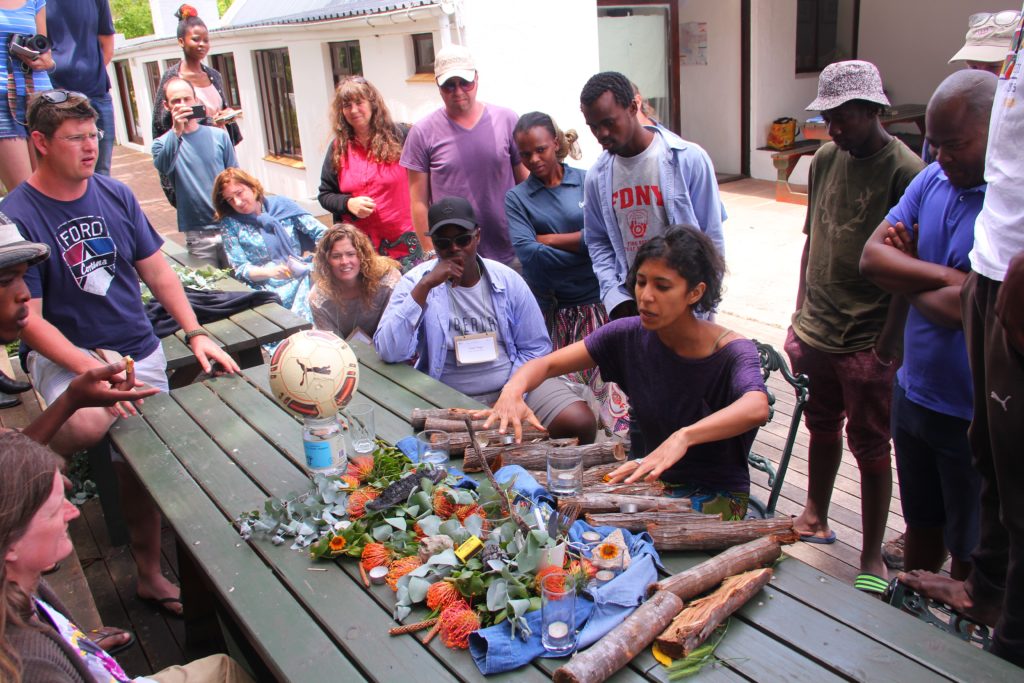
In Lindow’s book, a number of social innovators from Western Cape, South Africa are highlighted. Here, social innovator Zayaan Khan talks about foods indigenous to Western Cape during a workshop.
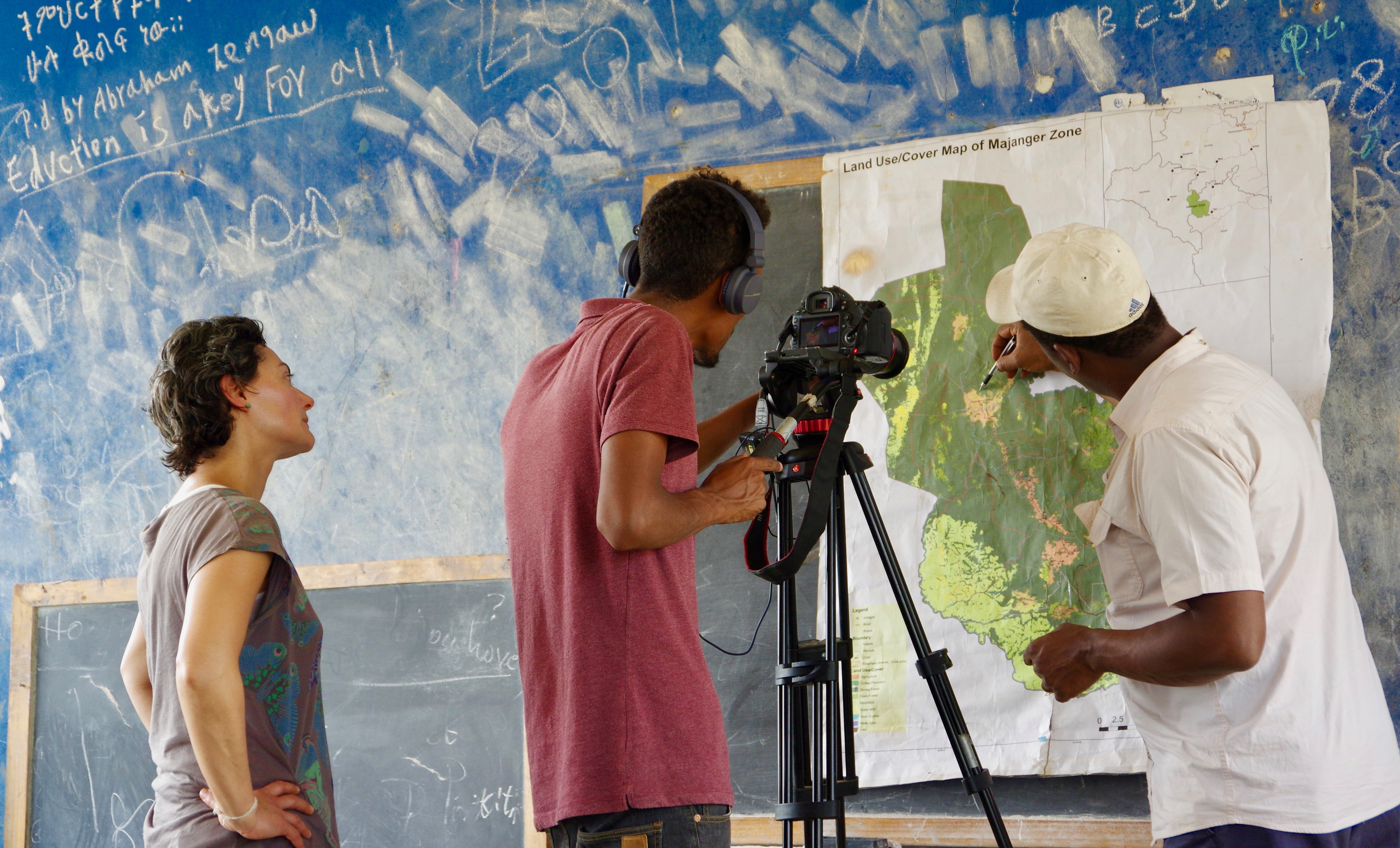 GRAID documentary film coming soon “Majang – cultivating a resilient food future for the people of the forest” Ethiopia’s population is quickly growing, a trend in many African nations. The Ethiopian national government’s agricultural policy is increasingly following a high chemical input model in order to increase crop yields. While agriculture harvests must keep up with the demands of a growing population, it is important to understand the lasting impacts that […]
GRAID documentary film coming soon “Majang – cultivating a resilient food future for the people of the forest” Ethiopia’s population is quickly growing, a trend in many African nations. The Ethiopian national government’s agricultural policy is increasingly following a high chemical input model in order to increase crop yields. While agriculture harvests must keep up with the demands of a growing population, it is important to understand the lasting impacts that […]
Ethiopia’s population is quickly growing, a trend in many African nations. The Ethiopian national government’s agricultural policy is increasingly following a high chemical input model in order to increase crop yields. While agriculture harvests must keep up with the demands of a growing population, it is important to understand the lasting impacts that these chemicals have on the natural environment.
A documentary film about GRAID researcher, Million Belay, gives a flavour of how resilience-oriented research sheds light on the complex, interconnected and wide-ranging social-ecological factors that need to be considered and addressed as part of the design for a sustainable and resilient food production system. He does so by asking the question: How can resilience-based research help to inform the development of food production systems that will deliver enough for everyone to eat, without degrading the environment and eroding culture?
The film’s narrative focuses on resilience research in one community experiencing multiple changes. This community lives in a forested region, and face challenges of population growth and immigration that bring about social and cultural changes. In turn, there are impacts on the environment, as a result of different farming practices and the way the forest is managed.
Using a deeply embodied understanding about his country’s political and cultural history, Belay, an Ethiopian native, uses methods based on a resilience approach to help the community find their own practical solutions to the complex problems they face. For example, he combines local and traditional ecological knowledge, and at the same time, the latest research on global trends in climate change. He places this data alongside current national policy on reforms to agriculture and foreign investments that are driving rapid economic expansion. All the while, he collaborates with the men and women who are part of the research process through participatory methods that create space for shared learning between the researcher and the community. Most importantly, this participatory process helps to build trust, understanding and clarity about steps the community itself can take to determine their future.
The way in which the research is carried out, and the local level outcomes, draw on resilience-oriented research and highlight knowledge and insights relevant far beyond this forest. Furthermore, the project goes some way in translating knowledge into hands-on practical actions that can inform a more sustainable and just development approach.
Synopsis of the film (20 minutes)
Belay takes us on a journey into the thick, low-lying forest of Majang, in southwestern Ethiopia. The area is changing quickly – the land is fertile and attracts business investments in coffee production, as well as settlers migrating from the highland regions of Ethiopia in search of land to clear for agriculture.
Belay is on a scoping mission to find out how the Majang, a community indigenous to Majang forest, are experiencing rapid changes in their social and ecological environments. Belay asks what kind of future they want.
The entry point he chooses is delving into the Majang community’s food production system.
What do the Majang people harvest from the forest? How do they farm? Embedding himself in the community, Belay works closely with elders, men and women. By focusing on food, Belay learns about the connections between the Majang people and the forest that has shaped their identity, culture and source of livelihood.
He discovers that the jang, an area of the Majang forest where bees produce honey, is important to the Majang people for a number of reasons. First, jang is an important part of the Majang peoples’ identity, as it is this specific part of the forest where their name is derived. Second, the honey is highly valued and currently forms an important source of local income. When patches of land are cleared for small-scale, mixed agriculture by the Majang community, they give careful consideration before felling the trees in which the bees build their hives.
However, everything is changing, and there are fewer certainties than ever before. The population is growing, and more forest is being cleared to grow food. At the same time, there are external pressures. Highland communities leave their increasingly arid, degraded and under-productive land and migrate to Majang, where the soil is fertile. Big business is investing in clearing forest for coffee plantations. At the national level, government policy favours high chemical input agriculture and less diversity of crops, which depletes soil quality, risks degrading the ecosystem, and poses potential human health risks. Meanwhile, rising global temperatures influence biophysical forces that shape the region, the African continent and the planet. Shifts in global patterns lead to less rainfall in the region and prolonged droughts.
Belay pulls together insights from resilience thinking as a guide through the complex, entangled, and always-changing dynamics between: humans and environment; the local, national, and global; and the social, political, and biophysical. His goal is to help the Majang people identify what kind of future they want, what kind of support they need, and what actions they can take now.
He uses research methods and approaches to draw out both men’s and women’s knowledge about the place where they live and the values they live by. As an Ethiopian himself, Belay is committed to finding pathways for development before the pressures facing the community and the forest reach breaking point. He strives to enable the community to make decisions about their future. In the end, the community gathers around a shared vision of the transformation they want to see that holds intact their identity as the people of the jang, in the Majang forest.
2018-03-07 In Between: Photos and film on memory, migration and resilience in South AfricaNow more than ever, we are on the move. People from all over are settling in places far from home, often in search of a better life. With migration now so commonplace, it inevitably has influenced our social and economic systems. For example, annual global remittance flows, money sent back home by foreign workers, now […]
In Between: Photos and film on memory, migration and resilience in South AfricaNow more than ever, we are on the move. People from all over are settling in places far from home, often in search of a better life. With migration now so commonplace, it inevitably has influenced our social and economic systems. For example, annual global remittance flows, money sent back home by foreign workers, now […]
Now more than ever, we are on the move. People from all over are settling in places far from home, often in search of a better life. With migration now so commonplace, it inevitably has influenced our social and economic systems.
For example, annual global remittance flows, money sent back home by foreign workers, now exceeds aid funding worldwide ($350 billion versus $130 billion, respectively). Global remittances have become central to questions of global development funding. However, with rising global tensions around migration, many are finding it harder to earn a living abroad. This stress is in turn transferred to communities they support through remittance.
In Between is a mixed collection of film and photography by Luke Metelerkamp, Steve McDonald,and Jules Macer, which explores food economy and culture in Belleville, South Africa, informally dubbed ‘Somali Town.’ Given the pivotal role which the food economy plays in migrants’ livelihood strategies and remittance flows back home, the exhibition uses food as an entry point for an exploration into memory, migration, and resilience. The work raises questions around our understandings of informal livelihoods, and the solidarity economy in the generation of remittance flows that support millions of families globally.
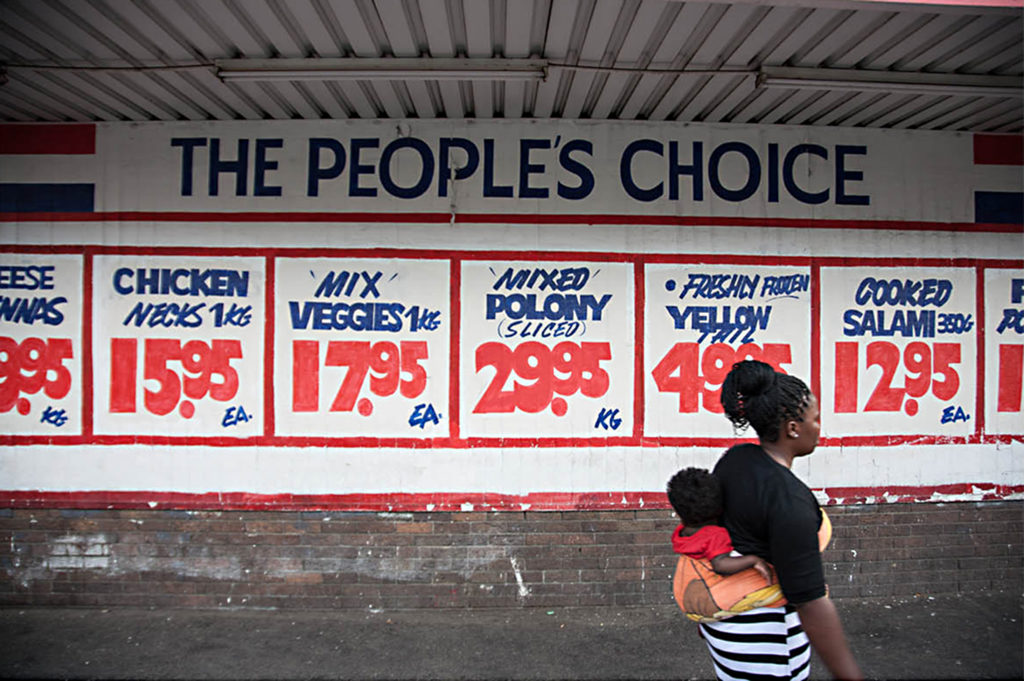
“In Between” uses food as a way to explore memory, migration, and resilience in Somali Town (Belleville, South Africa)
What does food have to do with remittance flows in Africa?
A closer look at the stories about these migrants showcase the interconnectedness and surprising nature that the food economy in Somali Town has on remittance flows all across the continent of Africa and beyond. The narratives personify the links between social tolerance in wealthy economies to the resilience and social wellbeing within regions in crisis. In doing so, the work highlights complex social teleconnections linking some of the wealthiest parts of the continent with the social welfare in some of the least stable and war-torn.
The art-based exploration also suggests that unlike the formal food system, the informal food economy serves as an important social safety net of last-resort for communities in exile. The informal food economy is central to building resilience among highly vulnerable communities in exile and the global social networks they support. Furthermore, the narratives from the exhibition suggest that food can also assist in ameliorating cultural discord in regions where refugees and other migrants settle.
This project was supported by GRAID through the Centre for Complex Systems in Transition (Stellenbosch, South Africa).
2017-11-01 Intersections of power and genderQuestions around who has access or who has the power to make decisions, are always relevant when studying natural resource management and environmental issues in the Anthropocene. Yet, these questions sometimes sit on the periphery of environmental research agendas. Some researchers are making it their job to put them at the forefront. GRAID has been […]
Intersections of power and genderQuestions around who has access or who has the power to make decisions, are always relevant when studying natural resource management and environmental issues in the Anthropocene. Yet, these questions sometimes sit on the periphery of environmental research agendas. Some researchers are making it their job to put them at the forefront. GRAID has been […]Questions around who has access or who has the power to make decisions, are always relevant when studying natural resource management and environmental issues in the Anthropocene. Yet, these questions sometimes sit on the periphery of environmental research agendas. Some researchers are making it their job to put them at the forefront.
GRAID has been working to advance the understanding of gender and power in the context of development in social-ecological systems. Stockholm Resilience Centre’s (SRC) GRAID programme hosted a workshop on power relationships in social-ecological systems on 3 October 2017.
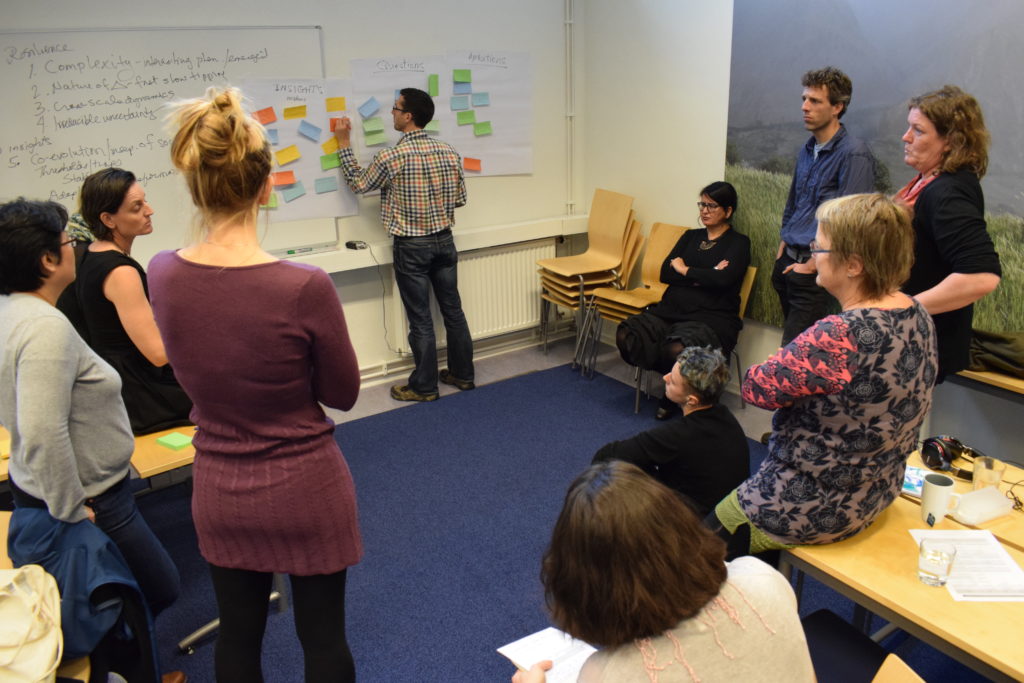
Putting power into gender, resilience and development workshop on 3 October 2017 at Stockholm Resilience Centre
The workshop, “Putting power into gender, resilience and development,” included a number of expert participants from GRAID, working at SRC and the University of Kent, as well as visiting experts from the Centre of International Forestry Research (CIFOR) in Indonesia, and the University of Helsinki.
Intersectionality as a way to understand power relationships
The workshop used the concept of intersectionality as an entry point for analyzing power. The concept of intersectionality, in this context, describes how people become positioned, socially and environmentally, in different contexts, as well as the material and social outcomes of these relationships, including shifting social power dynamics (Djoudi et al. 2016 – see below).
To introduce this mode of thinking, the workshop started with a presentation from workshop participant Houria Djoudi (CIFOR). Her work spans climate change, adaptation, intersections of social inequality, biodiversity, sustainable development, community ecology, and society and environment. She used a number of case studies from her work in different forest systems to explain how she uses intersectionality.
Workshop participants plan to keep pushing this thinking and work forward. Increasing understanding around questions of power and gender will not only help advance sustainability research, but also provide insights for transformative and inclusive development in the Anthropocene.
Interest and inquiries: michelle.dyer@su.se
2017-06-26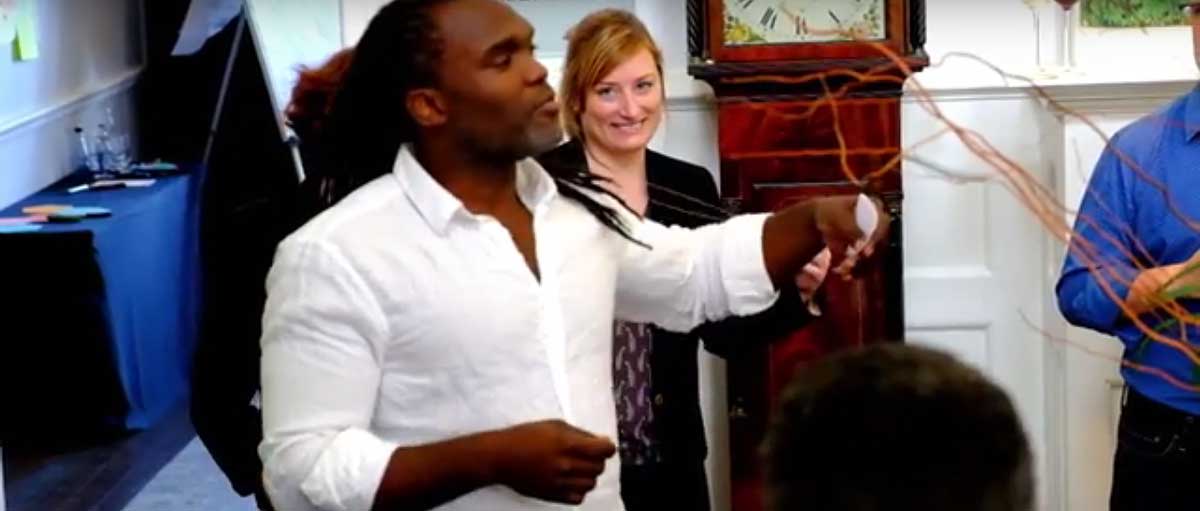 Creating positive visions of southern AfricaAt an ‘Anthropocene Visioning Workshop’ hosted by the CST in November 2016, a diverse group of key thinkers in southern Africa − including artists, social entrepreneurs, researchers, and policy-makers, was convened to engage in a visioning process to scope a range of plausible “good” futures based on perspectives from a variety of regional actors. Graphics: […]
Creating positive visions of southern AfricaAt an ‘Anthropocene Visioning Workshop’ hosted by the CST in November 2016, a diverse group of key thinkers in southern Africa − including artists, social entrepreneurs, researchers, and policy-makers, was convened to engage in a visioning process to scope a range of plausible “good” futures based on perspectives from a variety of regional actors. Graphics: […]
At an ‘Anthropocene Visioning Workshop’ hosted by the CST in November 2016, a diverse group of key thinkers in southern Africa − including artists, social entrepreneurs, researchers, and policy-makers, was convened to engage in a visioning process to scope a range of plausible “good” futures based on perspectives from a variety of regional actors. Graphics: G. Johnson/Graphic Harvest
The Anthropocene is the name for a new geological epoch in which humanity has become a dominant global force re-shaping the geological, biological and atmospheric dynamics of Earth. This means big challenges but also many opportunities. Ever-increasing technological progress and human development are opening up novel and exciting opportunities for addressing some of these key challenges. There is a need for alternative visions of the future that go beyond the typical narratives of collapse and dystopia.
Seeds of Good Anthropocenes
With this goal in mind, the Seeds of Good Anthropocenes initiative aims to collect and develop a suite of alternative visions for “Good Anthropocenes” – positive futures that are socially and ecologically desirable, just, and sustainable. This initiative is a collaboration between the Stockholm Resilience Centre, McGill University in Canada, and the Centre for Complex Systems in Transition (CST) at Stellenbosch University in South Africa. The objective is to counterbalance prevailing dystopic visions of the future that may be inhibiting our collective ability to move creatively towards a better trajectory for the Earth and humanity.
A key factor in this endeavour are the “Seeds” – mostly small-scale, experimental projects, organizations and initiatives that employ new ways of thinking or doing and exist at the margin of the current world. These can be new social institutions, technologies, or frameworks for understanding the world. Over the past two years, these Seeds have been collected in a database through global online surveys and a number of workshops, funded by Swedbio in Sweden.
Creative visioning
Now the Seeds have been used as a foundation upon which to build better futures. In a first exploratory workshop co-hosted by the GRAID programme and the CST, a diverse group of over 20 scientists, artists, and change makers were brought together in November 2016 in Cape Town, South Africa. Four groups of participants were formed, each starting with a set of three very different Seed projects and initiatives. Based on their Seeds, each group was tasked with imagining what southern Africa would be like if these Seeds were to grow, combine and become the new normal. Throughout the workshop the participants were actively encouraged to think outside the box and stretch their imaginations.
“Instead of extrapolating from the present and coming up with more recognizable alternative futures as one usually does with scenarios, we’ve come up with a process that starts with Seeds, which are essentially these little pockets of the future that exist in the present, but that are marginal.” Tanja Hichert, workshop facilitator
At the end of the two-and-a-half-day process, the groups presented their visions for the future to each other. From the start, creative expression was an integral part of the workshop, and all the groups brought their visions alive through theatrical performances including role-play and dance. In addition, a “graphic harvester” was engaged to visually capture the participants’ insights throughout the workshop, thus providing the graphic backbone for the different scenarios.
Watch video with Tanja Hickert explaining the visioning workshop process:
A shared outlook
Interestingly, the groups’ visions for southern Africa featured some striking commonalities, even though their starting points were so different. All scenarios placed a strong emphasis on decentralized decision-making and power, as well as collaboration over competition. Empathy is a core value that permeates all the future visons, and technological advances assist in connecting people to each other, but also to the biosphere. “Work” becomes about so much more than paying bills, and instead enables self-expression and community development. Most production and consumption processes are performed locally and in closed-loop systems, minimizing transport and waste. One of the key messages from this workshop is therefore that – beyond all our differences – we share a common vision of what a good, inclusive, equitable and sustainable future looks like.
Overall, the participants found the visioning process to be highly emotive, sometimes challenging, but ultimately inspiring:
“It’s been hard work. Emotionally difficult work. To think into the future and in that process to kind of really try very hard to let go of some of your pet ideas, things that make you feel comfortable. Some of your unquestioned ways of engaging with the world.” Workshop participant
The feedback indicates that the participants felt a greater responsibility, having gone through this process, to do what they can within their sphere of influence to make these positive visions of the future a reality.
For more reflections and lessons learned from the participants and organizers, please watch the reflections video below:
Further research and engagement
The southern African workshop was just the start. A second workshop, focusing on the northern European region, was held in Stockholm, and more workshops are planned across the globe. The Seeds of Good Anthropocenes project is ongoing, and contributes to one of the Stockholm Resilience Centre’s major research streams on large-scale transformations to sustainability. Forthcoming scientific papers will outline the visioning methods applied in the southern African case, as well as the storylines of the different scenarios and their points of convergence/divergence. The next phase in this line of research will then focus on comparing insights and learnings across the different case study regions, with the aim of developing a blue-print for the successful creation of transformative spaces in which positive futures can emerge.
More details on the process, as well as the artwork, can be found in the official workshop report
2017-06-26 An overview: The Colloquium on Resilience and DevelopmentIn the Anthropocene, humanity needs to deal with increasing turbulence, in both social and environmental settings. Resilience has been identified as a strategy that could help advance development across multiple, sectors, scales, and regions. As a forum to convene on these topics, the Colloquium on Resilience for Development: Assessment Methods and Transformative Practices was created. […]
An overview: The Colloquium on Resilience and DevelopmentIn the Anthropocene, humanity needs to deal with increasing turbulence, in both social and environmental settings. Resilience has been identified as a strategy that could help advance development across multiple, sectors, scales, and regions. As a forum to convene on these topics, the Colloquium on Resilience for Development: Assessment Methods and Transformative Practices was created. […]In the Anthropocene, humanity needs to deal with increasing turbulence, in both social and environmental settings. Resilience has been identified as a strategy that could help advance development across multiple, sectors, scales, and regions. As a forum to convene on these topics, the Colloquium on Resilience for Development: Assessment Methods and Transformative Practices was created.
From 8-10 May 2017, Stockholm Resilience Centre’s GRAID programme, the Centre for Complex Systems in Transition at Stellenbosch University, South African Council for Science and Industrial Research (CSIR), and the South African Program on Ecosystem Change and Society (SAPECS) jointly hosted the colloquium in Johannesburg, South Africa. The event aims to convene on how resilience can contribute to doing development differently, from both research and practical perspectives.
“The colloquium was designed to maximize opportunities for dialogue and critical discussions and building collaborations between researchers and practitioners. Much of the colloquium was centred on dialogue and mini-workshop sessions, interspersed with talks to maximize communication between participants,” says Oonsie Biggs, the Colloquium’s Chair organizer.
The colloquium was completely booked, and attracted over 150 researchers, practioners, and student from Africa, Europe, Oceania, and North America. It was designed around seven central themes, aimed at maximizing opportunities for discussion:
Resilience assessment, monitoring and evaluation
2. Creating transformative spaces
3. Urban resilience and infrastructure
4. Indigenous and local knowledge for stewardship and resilience
5. Science-society partnerships for building resilience and transformation
6. Addressing inequality and human wellbeing through ecosystem services
7. Human rights in the Anthropocene
8. Achieving the SDGs in Africa
An eventful 60 hours
The two-and-a-half-day colloquium hosted a number of sessions of short and long talks, ranging on topics from complexity and resilience thinking; social-ecological regime shifts; and human rights and food systems; and also, what resilience thinking and social-ecological systems can say about doing development differently.
During the event, three plenary sessions occurred, and was captured via livestream, with a number of keynote speakers: centre researchers Oonsie Biggs, Belinda Reyers, and Michele-Lee Moore, as well as Busiso Moyo (Sonke Gender Justice), Lorenzo Fioramonti (Centre for the Study of Governance Innovation, University of Pretoria) and Nathanial Matthews (Global Resilience Partnership). Each plenary concluded with a discussion, including a final panel hosted by GRAID’s ReThink Assistant Editor, Marika Haeggman.
The colloquium also highlighted art-science collaborations, such as the collaboration between ecological artistic Hannelie Coetzee and researcher Sally Archibald, who together create ecological images while studying controlled fire management. A photo exhibition by Gwen Meyer, Picturing Resilience in Northern Ethiopian Foodways, visualized how food acts as a source of resilience in Ethiopian communities.
Outcomes
As the colloquium came to a close, it was clear that it had been an informative and meaningful for many of the participants. As one of the participants reflects, “Many researchers are working in parallel, but not necessarily communicating,” while other participant says, “that this event created a space where I could connect with colleagues I want to continue speaking and collaborating with.”
Biggs also highlights the positive reactions she received about the colloquium. “The event was a great success! I’ve heard positive feedback from a number of attendees, and from a number of people who were following the event online.”
While this colloquium has only been planned as a one-off event, the organizers hope that a number of meaningful connections were made at the colloquium, which will help to further advance discussions on resilience, development, and dealing with turbulent social and environmental challenges in the Anthropocene.
